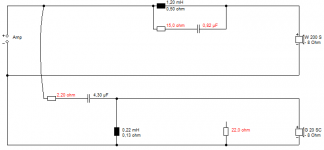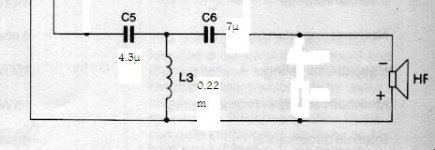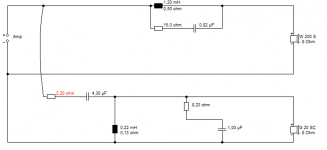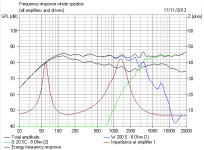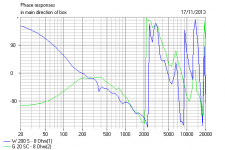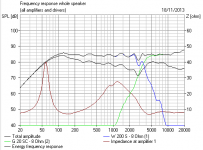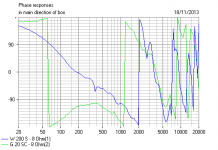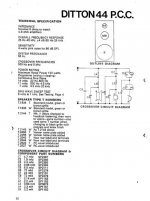Hello.
I'm french so you have to excuse my poor english🙂
I made some closed boxes around 17 liters to listen a Kef B200 SP1070 like the Celeste 3. I thought i can find easily the T/S of this speaker. But no😡 Impossible to find anything about it.
So, i try with this excellent forum. I ever ask the question in other forum but nothing.
Like a newbie, i listen it with a 1.2mh in series without any measure and the sound is "ok" but i'm sure i can obtain a better result with your help
The tweeter is the T3939 by Celestion. Same problem, anything on the net about it.
I put a 4.3µf in series and 0.22mh in parallel. The level of it is higher than the B200 and i think i can put a resistor in series before the 12db/o.
Is anybody have experiences with those speakers. The best is have some curves and the T/S.
Thanks for your attention and realy sorry for my english
David.
I'm french so you have to excuse my poor english🙂
I made some closed boxes around 17 liters to listen a Kef B200 SP1070 like the Celeste 3. I thought i can find easily the T/S of this speaker. But no😡 Impossible to find anything about it.
So, i try with this excellent forum. I ever ask the question in other forum but nothing.
Like a newbie, i listen it with a 1.2mh in series without any measure and the sound is "ok" but i'm sure i can obtain a better result with your help

The tweeter is the T3939 by Celestion. Same problem, anything on the net about it.
I put a 4.3µf in series and 0.22mh in parallel. The level of it is higher than the B200 and i think i can put a resistor in series before the 12db/o.
Is anybody have experiences with those speakers. The best is have some curves and the T/S.
Thanks for your attention and realy sorry for my english
David.
You may have better luck on this forum: Home Page hifiloudspeakers.info They're kind of KEF specialists, and some of the old KEF design engineers post..
I think your idea here is good. This is a 20cm KEF paper bass, sourced from ELAC I believe, and a soft dome tweeter which should be OK in a 20L closed box.
I would be adding a 2.2R or 3.3R resistance to the tweeter input to take it down. Maybe a 22R resistance across the tweeter too. 7-10 Watt wirewound usually.
The little circuit (15R + 0.82uF) across the 1.2mH bass coil can help too. It's a little notch for the 5kHz cone breakup that I like. It helps phase too.
This is really all you can do with this combination with a simple filter. It might sound rough on some vocals, but is pleasant enough. THe crossover is about 3kHz. 🙂
I would be adding a 2.2R or 3.3R resistance to the tweeter input to take it down. Maybe a 22R resistance across the tweeter too. 7-10 Watt wirewound usually.
The little circuit (15R + 0.82uF) across the 1.2mH bass coil can help too. It's a little notch for the 5kHz cone breakup that I like. It helps phase too.
This is really all you can do with this combination with a simple filter. It might sound rough on some vocals, but is pleasant enough. THe crossover is about 3kHz. 🙂
Attachments
Last edited:
You may have better luck on this forum: Home Page hifiloudspeakers.info They're kind of KEF specialists, and some of the old KEF design engineers post..
Thanks. I try them but nobody have anything (T/S or curves) about this woofer. Only some photos about a restoration ok Kef Celeste 3.
I think your idea here is good. This is a 20cm KEF paper bass, sourced from ELAC I believe, and a soft dome tweeter which should be OK in a 20L closed box.
I would be adding a 2.2R or 3.3R resistance to the tweeter input to take it down. Maybe a 22R resistance across the tweeter too. 7-10 Watt wirewound usually.
The little circuit (15R + 0.82uF) across the 1.2mH bass coil can help too. It's a little notch for the 5kHz cone breakup that I like. It helps phase too.
This is really all you can do with this combination with a simple filter. It might sound rough on some vocals, but is pleasant enough. THe crossover is about 3kHz. 🙂
WONDERFUL.
 I try it quickly and post my feel.
I try it quickly and post my feel.Longue life to this forum.
I think we SHOULD talk about the tweeter, otherwise this is hard to fix...what's wrong here? Does it just sound rough or too loud? Ferrofluid does dry out with old tweeters. 😀
My own feeling is that 3.3uF is about right for the first treble capacitor, followed by 7uF if you want. I was trying to work with what you have.
Polarity is positive for 200mm bass and 25mm treble here.
My own feeling is that 3.3uF is about right for the first treble capacitor, followed by 7uF if you want. I was trying to work with what you have.
Polarity is positive for 200mm bass and 25mm treble here.
BTW, here's the rough modelling for your setup. The 8.2R, 1uF Zobel is just a touch I like to roll off the tweeter top end. It's optional.
Hope it helps. 3.3uF is an option to reduce the midrange at crossover a little.
Hope it helps. 3.3uF is an option to reduce the midrange at crossover a little.
Attachments
I think we SHOULD talk about the tweeter, otherwise this is hard to fix...what's wrong here? Does it just sound rough or too loud?
Doesn't rough, but a little too loud yes.
Ferrofluid does dry out with old tweeters. 😀
I hope no😀but how can i verify this fact ?
My own feeling is that 3.3uF is about right for the first treble capacitor, followed by 7uF if you want. I was trying to work with what you have.
I work with a friend who have a lot of differents components
Polarity is positive for 200mm bass and 25mm treble here.
I ask the question of polarity because i ever read if i use a 6db/o for a woofer and a 12db/o for the tweeter i HAVE TO reverse the polarity on the tweeter. Is it true ?
So i will try your scheme but with the 7µf. Like this should i keep a positive or reversed polarity for the tweeter ?
Sorry if i'm boring for specialist, but it's so pleasant to be teach when you're a beginner like me😱
According to this link
Kef Crossover | Flickr - Photo Sharing!
the original woofer filter of the Celeste III is 2.7 mH and 5 uF.
Kef Crossover | Flickr - Photo Sharing!
the original woofer filter of the Celeste III is 2.7 mH and 5 uF.
That's a good bit of digging you did there, Dissi. Very nice work! 😎
I just ran that past Visaton Boxsim. The 2.7mH/5uF bass filter didn't work very well in my estimation, and the 5uF/0.2mH/7uF treble filter looked a bit peaky with a 6 ohm tweeter. But it's very hard to guess exactly what these drivers are like here. I am guessing the KEF paper woofer is about 1mH Le, whereas the W200S I used is about 2mH. So possibly some fine adjustments to do.
For the DIYer, I quite like what this Celestion Ditton 44 type 3rd order filter does. The bass coil turns out not to be very critical, and 1.2mH should work. I've never had much luck with LC bass circuits on 200mm woofers, so go for this gentler slope. But bass cone breakup is well suppressed, and the tweeter Fs resonance gets an easy ride too.
These old circuits are always interesting. They were done before computer modelling. Very skilled IMO, and Celestion did better paper speakers than anyone. 🙂
I just ran that past Visaton Boxsim. The 2.7mH/5uF bass filter didn't work very well in my estimation, and the 5uF/0.2mH/7uF treble filter looked a bit peaky with a 6 ohm tweeter. But it's very hard to guess exactly what these drivers are like here. I am guessing the KEF paper woofer is about 1mH Le, whereas the W200S I used is about 2mH. So possibly some fine adjustments to do.
For the DIYer, I quite like what this Celestion Ditton 44 type 3rd order filter does. The bass coil turns out not to be very critical, and 1.2mH should work. I've never had much luck with LC bass circuits on 200mm woofers, so go for this gentler slope. But bass cone breakup is well suppressed, and the tweeter Fs resonance gets an easy ride too.
These old circuits are always interesting. They were done before computer modelling. Very skilled IMO, and Celestion did better paper speakers than anyone. 🙂
Attachments
According to this link
Kef Crossover | Flickr - Photo Sharing!
the original woofer filter of the Celeste III is 2.7 mH and 5 uF.
Very good job Dissi😉.
A question please😱. The 2.7mh in series don't cut the beautiful midrange of this B200 ?
That's a good bit of digging you did there, Dissi. Very nice work! 😎
I just ran that past Visaton Boxsim. The 2.7mH/5uF bass filter didn't work very well in my estimation, and the 5uF/0.2mH/7uF treble filter looked a bit peaky with a 6 ohm tweeter. But it's very hard to guess exactly what these drivers are like here. I am guessing the KEF paper woofer is about 1mH Le, whereas the W200S I used is about 2mH. So possibly some fine adjustments to do.
For the DIYer, I quite like what this Celestion Ditton 44 type 3rd order filter does. The bass coil turns out not to be very critical, and 1.2mH should work. I've never had much luck with LC bass circuits on 200mm woofers, so go for this gentler slope. But bass cone breakup is well suppressed, and the tweeter Fs resonance gets an easy ride too.
These old circuits are always interesting. They were done before computer modelling. Very skilled IMO, and Celestion did better paper speakers than anyone. 🙂
I can answer when i'll translate (and understand) your post correctly😀😀
Thanks a lot for all your contributions.
The 2.7mh in series don't cut the beautiful midrange of this B200 ?
I really don't know. For most 8" drivers a lower value (1.5 mH -2.2 mH) would be more appropriate. But if the driver has a distinctly rising frequency response above 1 kHz 2.7 mH might be OK.
The different B200 vary in Q and powerhandling, the frequency responce on the bextrene coned B200 are similar to this
 . That lift from 1-4 kHz is also shared with a Audax bextrene driver.
. That lift from 1-4 kHz is also shared with a Audax bextrene driver.
There is no real rules for polarity. Shure there is for teoretical drivers with infinite bandwith, flat impedance mounted in the same plane for theoretical crossover. In reality all that goes out the window. Use what sounds best.
 . That lift from 1-4 kHz is also shared with a Audax bextrene driver.
. That lift from 1-4 kHz is also shared with a Audax bextrene driver.There is no real rules for polarity. Shure there is for teoretical drivers with infinite bandwith, flat impedance mounted in the same plane for theoretical crossover. In reality all that goes out the window. Use what sounds best.
I really don't know.
Now, i know😉It's not what i want. The midrange is too subded, like a
handkerchief in front of the woofer. Perhaps, that's the typical english sound and i get wind of him🙄
and i get wind of him🙄
For the tweeter, i've not found some 5µf and 7µf capa neither 0.2mh. So i used 5.6µf ; 0.18mh ; 6.8µf and it play too low. It's not nice to ear. I think the original tweeter of this diagram can play lower than the T3939.
 and i get wind of him🙄
and i get wind of him🙄For the tweeter, i've not found some 5µf and 7µf capa neither 0.2mh. So i used 5.6µf ; 0.18mh ; 6.8µf and it play too low. It's not nice to ear. I think the original tweeter of this diagram can play lower than the T3939.
Good estimation😀The 2.7mH/5uF bass filter didn't work very well in my estimation
I don't understand what "peaky" mean exactly. For google it mean like a medical word : tired, sick, seedyand the 5uF/0.2mH/7uF treble filter looked a bit peaky with a 6 ohm tweeter
If it mean that's not good, i agree😀
But it's very hard to guess exactly what these drivers are like here. I am guessing the KEF paper woofer is about 1mH Le, whereas the W200S I used is about 2mH. So possibly some fine adjustments to do.
For the DIYer, I quite like what this Celestion Ditton 44 type 3rd order filter does. The bass coil turns out not to be very critical, and 1.2mH should work. I've never had much luck with LC bass circuits on 200mm woofers, so go for this gentler slope. But bass cone breakup is well suppressed, and the tweeter Fs resonance gets an easy ride too.
These old circuits are always interesting. They were done before computer modelling. Very skilled IMO, and Celestion did better paper speakers than anyone. 🙂
I'll listen the 1.2mh with R15ohms+0.8µf for B200 and R1.8ohms 4.3µf 0.22mh without R22ohms for tweeter tomorow.
I'll try 3.3µf 0.18mh 10µf for the second speaker. A friend advice it and i'll can compare them.
Cordially.
Hi,
Well a threadful of halfbaked nonsense except for Dissi's post.
The 2.7mH inductor is for baffle step compensation.
For it to work right the tweeter needs to attenuated
properly to match as well as crossed over most likely.
I have no idea what the x/o for a 3 way has to do
with the proper x/o implementation for a two way.
You can't simulate a 2 way crossover using the wrong drivers.
Bassmid response, Le, and roll-off and the tweeters
response, roll-off and impedance peak all affect a
typical 2 way crossover design. Using the wrong
drivers only guarantees the pretty graphs are wrong.
rgds, sreten.
Well a threadful of halfbaked nonsense except for Dissi's post.
The 2.7mH inductor is for baffle step compensation.
For it to work right the tweeter needs to attenuated
properly to match as well as crossed over most likely.
I have no idea what the x/o for a 3 way has to do
with the proper x/o implementation for a two way.
You can't simulate a 2 way crossover using the wrong drivers.
Bassmid response, Le, and roll-off and the tweeters
response, roll-off and impedance peak all affect a
typical 2 way crossover design. Using the wrong
drivers only guarantees the pretty graphs are wrong.
rgds, sreten.
This B200 SP1070 is not bextrene in my opinion. It's paper with a coating, a little like my Davis 20MP8GAW. I seen some bextrene woofer (Kef 104ab, DIY with Audax 210) and they are really differents.
There is no real rules for polarity. Shure there is for teoretical drivers with infinite bandwith, flat impedance mounted in the same plane for theoretical crossover. In reality all that goes out the window. Use what sounds best.
Ok so that's why i have to try a lot of combinations. Sometimes it's difficult to hear the differents.😱
Hi
Dissi's is try to help me and it's nice🙂
I don't understand what you want to say when you talk about 3 way crossover. It's not the theme😱 ??
Yes, i agree. But it help me to have a start point😉And as System7 is saying "possibly some adjustement to do"
Cordially
Hi,
Well a threadful of halfbaked nonsense except for Dissi's post.
The 2.7mH inductor is for baffle step compensation.
For it to work right the tweeter needs to attenuated
properly to match as well as crossed over most likely.
I have no idea what the x/o for a 3 way has to do
with the proper x/o implementation for a two way.
Dissi's is try to help me and it's nice🙂
I don't understand what you want to say when you talk about 3 way crossover. It's not the theme😱 ??
You can't simulate a 2 way crossover using the wrong drivers.
Bassmid response, Le, and roll-off and the tweeters
response, roll-off and impedance peak all affect a
typical 2 way crossover design. Using the wrong
drivers only guarantees the pretty graphs are wrong.
rgds, sreten.
Yes, i agree. But it help me to have a start point😉And as System7 is saying "possibly some adjustement to do"
Cordially
- Status
- Not open for further replies.
- Home
- Loudspeakers
- Multi-Way
- DIY with Kef and Celestion
